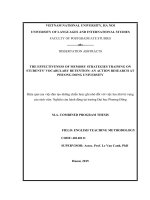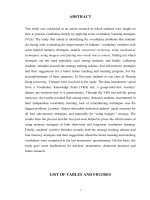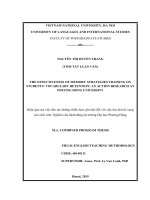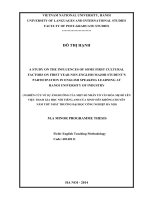The influences of ming qing fictions on southern vietnamese fictions during 1900 1930
Bạn đang xem bản rút gọn của tài liệu. Xem và tải ngay bản đầy đủ của tài liệu tại đây (220.58 KB, 29 trang )
Ministry of Education and Training
Ho Chi Minh City University of Pedagogy
******
WANG JIA
The Influences of Ming Qing Fictions on Southern
Vietnamese Fictions During 1900-1930
Summary Of Doctoral Thesis
Ho Chi Minh City, 2016
Ministry of Education and Training
Ho Chi Minh City University of Pedagogy
******
WANG JIA
The Influences of Ming Qing Fictions on Southern
Vietnamese Fictions During 1900-1930
Specialty: Vietnamese literature
Code: 62 22 01 21
Summary Of Doctoral Thesis
Ho Chi Minh City, 2016
This thesis was completed at
UNIVERSITY OF PEDAGOGY
HO CHI MINH CITY
Scientific instructor: Prof., Dr. HUYNH
̀
NHU ̛
PHUONG
̛ ̛
Reviewer 1: AP., Dr. Trần Nho Thìn
Reviewer 2: Dr. Phan Thu Vân
Reviewer 3: AP., Dr. Đoàn Lê Giang
The thesis will be defended to the institution-level doctoral
thesis reviewer council at Ho Chi Minh City University of
Pedagogy.
Time: .......:....., (day)............(month).............(year).........
This thesis can be found at
- Library of Ho Chi Minh City University of Pedagogy
- General Sciences Library of Ho Chi Minh City
1
Introduction
1. Rationale and objectives of the study
There was a trend of translating traditional Chinese fictions into
national language script (chữ Quốc ngữ) in the early 20th century,
among which Ming Qing fictions accounted for a significant part.
Exploring the translation works is necessary and important to clarify
the translation and spread situation of Chinese Ming Qing fictions in
the early 20th century in Vietnam, especially in southern Vietnam.
The translation works had a profound effect on the writing
practices of southern Vietnamese writers at that time. Therefore,
examining the relationship between the trend of translating Ming
Qing fictions and southern Vietnamese fictions in the early 20th
century will contribute to understanding the southern Vietnamese
writers’ acception of Ming Qing fictions in the early 20th century. In
addition, this study also introduces some southern Vietnamese
fictions so that readers can have a better knowledge about southern
Vietnamese literature.
2. Previous studies
Previous studies on the influence of Ming Qing fictions on
southern Vietnamese fictions during 1900-1930 can be divided into
two categories: the trend of translating Ming Qing fictions in
Vietnam in the early 20th century; the influence of Ming Qing
fictions on southern Vietnamese fictions in the early 20th century.
A retrospective analysis of previous studies shows that both
China and Vietnam have conducted a few research projects about the
2
influence of Ming Qing fictions on Vietnamese literature in general
and southern Vietnamese fictions in particular in the early 20th
century. However, some problems remain unsolved:
1. The research projects in China are too simple, not going deep
into the problem. Research projects on the literary exchanges
between China and Vietnam are still limited to the medieval time
period.
2. In Vietnam, in spite of the large quantity, many research
projects on the trend of translating Chinese fictions only stay in
stating the causes of the trend or describing the sales of translated
Chinese fictions, absent of comparison between translated and
original text. They don’t go deep either into the influence of Chinese
fictions on southern Vietnamese fictions; especially the adaption
phenomenon is studied much less.
Therefore, we have found that collecting and studying the
translation of Ming Qing fictions will be necessary and interesting.
And the influence of Ming Qing fictions on southern Vietnamese
fictions in the early 20th century also remains much to be studied in
depth.
3. Objects and scope of the study
3.1. Objects of the study
The objects of this study are the Ming Qing fictions that had been
translated into Quốc ngữ and some prose fictions written in Quốc
ngữ in southern Vietnam in the first 30 years of the 20th century.
3.2. Tasks of the study
3
1. The thesis studies the translation of Ming Qing fictions in
Vietnam, especially in the South in the early twentieth century,
including the causes of the trend, genres, main contents of the
translation works, publishing methods, translation styles, etc.
2. The thesis explores the influence of Ming Qing fictions on
southern Vietnam fictions in the early twentieth century in terms of
content and form.
3.3. Scope of the study
The thesis examines the Ming Qing fictions that had been
translated into Quốc ngữ in the first 30 years of the 20th century,
mainly focusing on 38 translation works that have been collected.
At the same time, the thesis examines the Quốc ngữ fictions
published in the South in the first 30 years of the twentieth century
that were obviously influenced by Ming Qing fictions like historical
fictions and martial arts fictions.
The thesis also studies in depth the adaptation fiction Người bán
ngọc by Lê Hoằng Mưu and the original short story Hương Thái Căn
cải trang gian dâm mệnh phụ in a short story collection called Hoan
hỷ oan gia in China.
4. Research methods
To perform the tasks above, this thesis mainly uses the following
research methods: historical method, comparative - contrastive
method, statistical classification method.
4
5. Thesis contributions
1. Analyzes in depth the trend of translating Ming Qing fictions in
southern Vietnam in the 20th century.
2. Sets up a bibliography including the Ming Qing fictions that
were translated in Vietnam in the first 30 years of the 20th century.
3. Studies the influence of Ming Qing fictions on southern
Vietnamese fictions in terms of content.
4. Analyzes the specific writing styles that southern Vietnamese
literature accepted from Ming Qing fictions such as serial structure,
narrative art, language, putting verses into fiction, etc.
6. Thesis outline
In addition to the introduction, conclusion and appendix, the
thesis includes three chapters:
Chapter 1: The situation of translating and publishing Chinese
Ming Qing fictions in Vietnam in the early 20th century (19001930)
Chapter 2: The influences of Ming Qing fictions on southern
Vietnamese fictions in the early 20th century in terms of content
Chapter 3: The influences of Ming Qing fictions on southern
Vietnamese fictions in the early 20th century in terms of writing
techniques
5
Chapter 1
The situation of translating and publishing Chinese Ming
Qing fictions in Vietnam in the early 20th century (1900-1930)
1.1. Overview of Ming Qing fictions
During Ming – Qing dynasties, Chinese classical fictions reached
the peak; the elements of fiction as subject, structure, writing
techniques were fully developed; many masters of fiction appeared
such as La Quán Trung, Thi Nại Am, Ngô Thừa Ân, Tiếu Tiếu Sinh,
Phùng Mộng Long, Lăng Mông Sơ, Ngô Kính Tử, Tào Tuyết Cần,
Bồ Tùng Linh with timeless masterpieces Tam Quốc diễn nghĩa,
Thuỷ hử truyện, Tây Du Ký, Kim Bình Mai, Nho lâm ngoại sử, Hồng
Lâu Mộng, Liêu trai chí dị and so on. During Ming – Qing dynasties,
Chinese writers composed about 2000 fictions written in both
classical and vernacular Chinese. Many genres of fiction appeared
such as "historical romance fiction", "legendary hero fiction", "godevil fiction", "secular fiction", "judical detection fiction", "scholarbeauty fiction","chivalrous fiction" and so on. Ming Qing fictions are
representative of Ming – Qing literature, and some completed the
highest
achievement
in
classical
Chinese
literature,
even
contemporary literature is hard to match them.
1.2. The spread of Ming Qing fictions in Vietnam before the
20th century
Before the twentieth century, Chinese Ming Qing fictions had
been spread to Vietnam in different ways. Vietnamese envoys to
China often took the opportunity to buy many Chinese books back to
6
Vietnam, including Ming Qing fictions. The envoys contributed to
forming a critical path for the spread of Ming Qing fictions in
Vietnam.
These Ming Qing fictions had circulated and exerted a major
influence on the life of literature, theater arts in Vietnam before the
twentieth century. In his doctoral thesis Nghiên cứu về quan hệ giữa
truyện Nôm và tiểu thuyết Trung Quốc (1974), Trần Quang Huy
listed stories written in Nom characters that were influenced by Ming
Qing fictions such as Truyện Kiều với Kim Vân Kiều truyện, Truyện
kỳ mạn lục với Tiễn đăng tân thoại, Nữ tú tài truyện với Nữ tú tài di
hoa tiếp mộc, Nhị độ mai với Trung hiếu tiết nghĩa Nhị độ mai, Tây
Du truyện với Tây Du Ký and so on. Besides, some stories in Ming
Qing fictions were adapted into stage play scripts, helping the
Vietnamese people become familiar with many character images in
Chinese stories such as Trương Phi, Tào Tháo, Quan Vân Trường ...
and thereby indirectly exposed to Ming Qing fictions, despite the fact
that they might not know Chinese or Nom characters.
In this way, the main content and characters in some Ming Qing
fictions were arguably familiar to the Vietnamese people.
1.3. The translation of Ming Qing fictions in Vietnam during
1900-1930
According to Professor Nhan Bảo, from 1900-1960 in Vietnam,
316 books were translated from Chinese fictions (republications
excluded), and according to Thư mục văn học Sài Gòn và Nam Bộ từ
1866-1930 by Bùi Đức Tịnh, only in the South were 135 Chinese
7
fictions translated during 1900-1930. In the two statistics above,
most books are Ming Qing fictions.
Through research and comparison of the titles and the content of
the fictions listed in the two sources above and the Chinese fictions
mentioned in Văn học Quốc ngữ ở Nam Kỳ 1865-1930 (Bằng
Giang), Văn học quốc ngữ trước 1945 (doctoral thesis of Võ Văn
Nhơn), Phác thảo quá trình hình thành tiểu thuyết văn xuôi quốc
ngữ ở Nam Kỳ cuối thế kỷ XIX đầu thế kỷ XX (article of Nguyễn
Khuê), Ảnh hưởng của tiểu thuyết Tam Quốc diễn nghĩa và sự tiếp
nhận tác phẩm này ở Nam Kỳ đầu thế kỷ XX (article of Lưu Hồng
Sơn), as well as 38 translations of Chinese fictions that we have
collected and the translation works kept in the library of Harvard
University, Cornell University with many definitive books setting up
bibliographies of popular fictions and Chinese Ming Qing fictions 1,
we have built a bibliography of Ming Qing fictions that were
translated into Quốc ngữ (1900-1930). The bibliography includes
136 works (republications excluded) translated from 72 Ming Qing
fictions. The publication time of 12 translation works among them
remain unclear.
1.4. The causes that lead to the trend of translating Ming Qing
fictions in Vietnam in the early twentieth century
To implement the assimilation policy, the French colonists
advocated for translating Chinese classics to propagate Quốc ngữ.
1
Our main references include: 《《《《《《《《《《《《《《《《《《《《《《《《《《《《《《《《
《《《《《《《《《《《《《《,《《《《《《《《《《《《《《《《《《《《《《《《《《《《《《《《《《《
《《《《《《《《《《《《《《《《 as well as bibliography at Fu Ssu-nien Library, Taiwan and
bibliography of Ming Qing fictions at Chinese Library of National University of Singapore.
8
Due to the encouragement of French authorities, many Vietnamese
who knew well of Chinese and Western learning such as Trương
Vĩnh Ký, Huỳnh Tịnh Của, Trương Minh Ký ... embarked on
translating Chinese classics into Quốc ngữ, including many Ming
Qing fictions.
Since Ming Qing fictions were no stranger to the Vietnamese
people, the translated works were popular among all classes of the
society and were much in demand on the market. The trend of
translating Ming Qing fictions in Vietnam in the early twentieth
century had thus been formed.
1.5. The characteristics of the trend of translating Ming Qing
fictions in Vietnam during 1900-1930
The trend of translating Ming Qing fictions in Vietnam started in
the South in the early twentieth century. In the first 20 years, 67
translation works of Ming Qing fictions appeared in the South while
only Phan Kế Bính’s translation of Tam Quốc Chí diễn nghĩa was
published in the North.
Ming Qing fictions were favourites among readers: a Ming Qing
fiction had several different translations, many fictions were
republished several times in a short time and their print runs were
also very large. Publishers competed in translating and publishing
Ming Qing fictions to make money.
There were quite a few participants engaged in the trend of
translating Ming Qing fictions: according to our incomplete
statistics, 56 Vietnamese translators contributed to the translation of
9
Ming Qing fictions in 30 years.
Mainly 6 genres of Ming Qing fictions were translated into Quốc
ngữ during 1900-1930: historical romance fiction, legendary hero
fiction, scholar-beauty fiction, chivalrous fiction, secular fiction and
god-evil fiction. Legendary hero fiction(18 works) and historical
romance fiction(17 works) were two most translated genres, mainly
about the “disordered times” in Chinese history such as the Three
Kingdoms period, the Sui Tang period, the late Northern Song
Dynasty and loyal, brave heroes like Dương gia tướng, Địch Thanh,
Tiết Đinh San, Tiết Nhân Quý... When translating Ming Qing
fictions, Vietnamese translators often chose short titles for their
translated books, or even renamed them entirely differently to attract
readers.
At that time, the translation works of Ming Qing fictions were
often posted in newspapers or printed into small books for
publication.
In terms of translation style, the translators often used simple
sentences easy to understand when they translated Ming Qing
fictions. To be faithful to the original text, they usually kept the
Chinese words by using Sino-Vietnamese phonology and adding
some explanations. When translating Ming Qing fictions, the
translators didn’t confine themselves to any form. They might make
deletions and additions to the original books, as long as the story
would be complete and attractive.
1.6. The translated book Tiểu hồng bào hải thoại phenomenon
10
The bibliography Thư mục tiểu thuyết và đoản thiên tiểu thuyết
Nam Bộ (1887-1932) in Tiểu thuyết Nam Bộ cuối thế kỷ XIX đầu thế
kỷ XX sees Tiểu hồng bào hải thoại as a fiction written by Nguyễn
Chánh Sắt orginally and was published by publisher Nguyễn Văn
Viết in 1923. Based on the examination of the 1930 version of Tiểu
hồng bảo hải thoại (published by Nguyễn Khắc), with a sentence on
the cover “Traduit en quốc-ngữ Nguyễn-Chánh-Sắt (Tân-châu)”, we
can be certain that Tiểu hồng bào hải thoại was not a fiction written
by Nguyễn Chánh Sắt but his translation work from Chinese fiction
Hải công tiểu hồng bào toàn truyện of the Qing Dynasty.
Summary
A trend of translating and publishing Ming Qing fictions appeared
in the South in the first three decades of the twentieth century with
more than 70 Ming Qing fictions translated and introduced.
Legendary hero fiction and historical romance fiction were two most
translated genres in this trend. Ming Qing fictions were widely
welcomed by all classes of people, both in city and in countryside.
Traditional moral codes such as loyalty, filial piety, chastity,
righteousness and courageousness contained in Ming Qing fictions
had contributed to the preservation of Vietnamese traditional culture.
In addition, the emergence of the trend had also promoted the
modernization of Vietnamese literature. We can say that the trend of
translating Ming Qing fictions was one of the motivations for the
writers to produce the Vietnamese people’s own literary works.
11
Chapter 2
The influences of Ming Qing fictions on southern Vietnamese
fictions in the early 20th century in terms of content
2.1. The influence on the notion of fiction
The notion of fiction in Vietnam has been deeply influenced by
China since the medieval time. In the early twentieth century, though
writers were still influenced by Chinese literature, the increasing
exposure to western literature acquainted them with the notion of
"roman" of France. At that time, the notion of fiction was reflected in
essays discussing the fictions or articles on fiction criticism scattered
in newspapers.
2.2. The influence on the perspective of writing
The trend of translating Chinese fictions in the early twentieth
century had brought both positive and negative impacts on southern
Vietnamese literature. On the positive side, the trend stimulated
inspirations of southern Vietnamese writers in writing Vietnamese
history and stories. On the negative side, many works at that time
didn’t break the serial structure frame, traditional in Chinese fictions.
2.3. The influence on the interpretation of history
There is a “telling historical stories as a folk art” tradition in
Chinese literature. Writers consciously used historical romance
fictions to interpret history and popularize the knowledge of history.
Therefore, history and historical figures have become important
topics in Chinese classical fictions.
In the early twentieth century, historical romance fictions were
12
widely translated and published in southern Vietnam and were
popular among readers. Chinese Ming Qing historical romance
fictions spread and were well-received in the South both in width and
depth.
The writers were aware of the role of historical fictions. For this
reason they wrote on the subject of history to make Vietnamese
people know their own history. They hoped that these works could
evoke Vietnamese national pride when their country was invaded by
French colonists. With this in mind, in the first three decades of the
twentieth century, some southern Vietnamese writers had written
fictions telling stories of Vietnamese people and society. They
include: Phan Yên ngoại sử tiết phụ gian truân (1910) by Trương
Duy Toản, Nặng gánh cang thường (1928) by Hồ Biểu Chánh, Việt
Nam Lê Thái Tổ (1929) by Nguyễn Chánh Sắt, Việt Nam anh kiệt
(1926) and Việt Nam Lý trung hưng (1929) by Phạm Minh Kiên,
Giọt máu chung tình (1926) and Gia Long tẩu quốc (1930) by Tân
Dân Tử.
2.4. The influence on the perception of education
Vietnamese medieval literature was influenced by the notion of
"writing is for conveying doctrine". By the early twentieth century,
this notion was still affecting the writing perspective of southern
Vietnamese writers. When writing fictions, they "always put didactic
and moralistic teachings of humanity and morality in the first place
in their works". We can say that the perception of education was
expressed quite clearly in southern Vietnamese fictions in the early
13
twentieth century, especially the traditional moral concepts such as
“loyalty, filial piety, chastity, righteousness", "three cardinal guides
and the five constant virtues". In particular, “loyalty” was considered
as an important topic and was most elevated in historical and martial
arts fictions. Here, "loyalty" meant not only loyal to the monarch, but
also to the nation and patriotism.
2.5. The influence on the perception of characters
In Chinese classical fictions, especially historical romance
fictions and magic hero fictions, the characters were often divided
into two groups: the positive and the negative. Positive characters are
representatives of justice, of traditional moral codes; negative
characters are representatives of crafty or treasonous figures. The
fiction theme is expressed through the conflicts between positive
characters and negative characters. With the traditional notion
“writing is for conveying doctrine" in mind, Chinese writers placed
the expectation of teaching people traditional moral codes on
positive characters by their language and behaviours.
The perception of characters mentioned above may also be found
in southern Vietnamese fictions in the early twentieth century. In
historical romance fictions and chivalrous fictions often appeared
two types of characters: positive and negative. The writers made a
clear distinction between the two types, without any confusion. By
behaviours, dialogues and monologues of the characters, the writers
expressed the notion of moral education and evoked patriotism of the
people.
14
Summary
The trend of translating Ming Qing fictions in the early twentieth
century has stimulated the aspirations and inspirations of Vietnamese
writers. At that time Vietnamese people loved reading Chinese Ming
Qing fictions, knew well Chinese history stories and heroic figures
but were not familiar with their own history. That being the case,
many Vietnamese writers felt very painful. They were aware of the
need of writing fictions to arouse the national spirit. As Bằng Giang
wrote, " Phạm Minh Kiên, Tân Dân Tử, Hồ Biểu Chánh couldn’t
stand the paradoxical situation that Vietnamese people just
translated books and praised heroes of someone else but neglecting
heroes on the Vietnamese land". Therefore, writers began to write
fictions about the Vietnamese people and Vietnamese stories. In the
process of writing, they had learned and received a lot from Chinese
fictions including the perspective of writing, the interpretation of
history, the perception of education and the perception of characters.
Chapter 3
15
The influences of Ming Qing fictions on southern Vietnamese
fictions in the early 20th century in terms of writing techniques
3.1. Serial structure
At the end of the transitional period of the 19th century and the
early 20th century, serial structure had been commonly accepted by
the southern Vietnamese writers. They used the structure to write
historical fictions, martial arts fictions or detective fictions.
However, the southern Vietnamese writers did not confine
themselves by serial structure. They sought to simplify it, thereby
creating a serial structure that carried Vietnamese characteristics.
In Chinese Ming Qing fictions written in serial structure, the main
contents of each chapter (hồi) were summarized at the beginning of
the chapter, known as couplet chapter titles (hồi mục). Southern
Vietnamese fictions written in serial structure had adopted this
writing style, especially from Ming fictions. The couplet chapter
titles were written in a simple and unadorned way but still showed
explicitly the important details of each chapter.
In the fictions written in serial structure, the writers also made
some changes to couplet chapter titles. For example, they used
Roman letters I, II ... like most western fictions to replace
"Chapter ... (Hồi thứ…)”. Southern Vietnamse writers at that time
consciously tried to get rid of the impact of Chinese classical fictions
and the limitations of serial strucutre. Instead they boldly learned and
wrote in western literature’s structure, thus making their works step
onto the modern way.
16
3.2. Narrative art
As a result of the trend of translating Chinese Ming Qing fictions
in general and historical romance fictions in particular, narrative art
of Chinese classical fictions had been accepted deeply by southern
Vietnamese writers in terms of narrative time and narrative rhythm.
Due to the “storytelling” nature, Ming Qing fictions were
different from western literature. Linear narration was the most
common way of storytelling in Ming Qing fictions. In southern
Vietnamese fictions in the early twentieth century, especially those
on historical themes, linear narration was also an important narrative
method. Traditional narrative art in Chinese classical fictions such as
chronological
narration,
interweaving
narration,
predictive
narration ... were widely used in southern Vietnamese fictions. In
addition, southern Vietnamese fictions also used fast and slow
rhythm in narration as in Ming Qing fictions, making the fictions
more lively and interesting.
Through the analysis above, we can see that southern Vietnamese
fictions in the early twentieth century shared many similarities with
Chinese classical fictions in terms of narrative art. Especially in the
southern Vietnamese historical fictions in the early twentieth
century, traces of Chinese classical fictions can be seen more clearly.
In our opinion, for the purpose of popularizing history knowledge,
infusing moral codes, evoking patriotism, the writers had to choose a
way of narration that Vietnamese readers could find easy to accept.
And because of the widespread influence of Chinese historical
17
romance fictions in Vietnam, linear narration had become familiar to
Vietnamese readers. Therefore, it is understandable that southern
Vietnamese writers chose the traditional way of linear narration to
write historical fictions.
3.3. Language
When writing fictions, southern Vietnamese writers in the early
twentieth century paid much attention to use colloquial language to
make them more understandable for readers. But the influence of the
Chinese language was still able to be traced in literature works, such
as antithesis sentences, idioms, verses, Chinese literary allusions...
3.3.1. Antithesis sentences
By the early 20th century, antithesis sentences were still used
quite widely in southern Vietnamese fictions. In the works of
Nguyễn Chánh Sắt, Lê Hoằng Mưu, Phạm Minh Kiên, Tân Dân Tử,
Hồ Biểu Chánh ... all appeared antithesis sentences. Antithesis
sentences were used when depicting landscapes, personalities of
characters, psychological activities, and expressing emotions through
scenery...
3.3.2. Borrowing Chinese idioms and sentences
Although southern Vietnamese writers paid attention to use
colloquial language, works in the early twentieth century still
"remained a clear trace of language in Chinese fictions". Southern
Vietnamese fictions in the early twentieth century still used many
Sino-Vietnamese words; borrowed many idioms and sentences from
China. It is clearly reflected in the works of Nguyễn Chánh Sắt,
18
Phạm Minh Kiên ... Vietnamese writers tried their best to absorb,
vietnamize Chinese words and sentences to enrich the Vietnamese
language treasury. This is arguably a prominent feature in southern
Vietnamese fictions in the early twentieth century.
3.3.3. The phenomenon of borrowing plots and characters
from Ming Qing fictions
In addition to borrowing idioms, sentences from the original text,
there was also a phenomenon of borrowing plots from Ming Qing
fictions in southern Vietnamese works in the early twentieth century.
The purpose was to describe something or to make a metaphor. The
plots and characters in Tam Quốc were widely used by writers in the
works like Việt Nam Lê Thái Tổ, Việt Nam anh kiệt …
Borrowing plots and characters from Ming Qing fictions to
describe events or characters in southern Vietnamese fictions in the
early twentieth century made the stories more vivid, closer to
readers, because Vietnamese people were acquainted with such
characters through translated and published Chinese works.
The phenomenon again demonstrated the deep level of
acceptance of Chinese literature in general, Ming Qing fictions in
particular by southern Vietnamese writers and readers.
3.4. Verses in the fictions
Beginning from legendary hero fictions of the Tang Dynasty, the
phenomenon of bringing verses into fictions had come into being.
When they developed into Ming Qing fictions, this writing method
became widespread. Verses, lyrics appeared in almost every fiction.
19
The phenomenon of bringing verses into southern Vietnamese
fictions was also quite common. In the process of accepting the
influences of Chinese Ming Qing fictions, the writers not simply
imitated but combined them with the characteristics of Vietnam
poetry. The verses in the fictions were usually composed in
Vietnamese traditional six-eight (lục bát) form.
3.5. The art of creation and adaption: a case study of the
fiction Người bán ngọc
Based on the research project of Võ Văn Nhơn, the foreword that
Lê Hoằng Mưu wrote for the fiction Người bán ngọc, as well as our
deep examination of the text of Người bán ngọc and Chinese short
fictions collection Hoan hỉ oan gia of the Qing Dynasty, we can
confirm that Người bán ngọc borrowed and re-created the content of
Chapter 4 from Hương Thái Căn cải trang gian dâm mệnh phụ in
Hoan hỉ oan gia. The author turned a short fiction with mere 7920
words into a 183-page fiction. In the fiction Người bán ngọc, Lê
Hoằng Mưu did not change much in terms of structure, main
characters of the story Hương Thái Căn cải trang gian dâm mệnh
phụ, but only changed the time from the end of the Ming Dynasty to
"the Republic of China"(Trung Huê dân quốc); relocated from
Yangzhou (Dương Châu) to Suzhou (Tô Châu), and changed the
characters’ names. Meanwhile, to enrich the contents of the story, the
author created some other characters. In Người bán ngọc, the author
paid attention to describe characters’ psychology, a writing style very
different from Chinese Ming Qing fictions, bearing traces of western
20
fictions. In these ways, this fiction was a blend of Asian and
European arts, making readers feel fresh and attractive. Compared
with the short story Hương Thái Căn cải trang gian dâm mệnh phụ,
the content of Người bán ngọc was richer and more attractive. The
characters were more vividly portrayed too.
Summary
Through our study on the text of southern Vietnamese fictions in
the early twentieth century, we find that serial structure in Chinese
classical fictions was widely used in southern Vietnamese literature
at the time. In the works of this period, the writers preferred
borrowing Chinese words, idioms as well as plots and characters in
Ming Qing fictions to increase the language vitality, or quoting
Chinese verses, sentences to enrich the content. Along with
accepting the influences of Chinese Ming Qing fictions’ writing
techniques, southern Vietnamese writers in the early twentieth
century were also influenced by western literature. Through the
research of writing techniques of southern Vietnamese fictions in the
early twentieth century, we can reach the conclusion that while
heavily influenced by Ming Qing fictions, the writers had gradually
divorced from their influence and tried to adopt? some modern
writing techniques. The writers absorbed the essence of Chinese and
western literary art in their writing activities. This had contributed
greatly to the modernization of Vietnamese literature in the early
20th century.
21
Conclusion
Through our study on the trend of translating Ming Qing fictions
and the situation of writing southern Vietnamese fictions during
1900-1930, the following conclusions can be drawn:
First, in the late nineteenth century and early twentieth century,
to gradually eliminate the influences of Chinese culture in general,
Chinese characters (chữ Nho) in particular, French colonists
vigorously promoted the policy of popularizing chữ Quốc ngữ. But
few books were originally written in chữ Quốc ngữ, so the French
supported translating Chinese classics and Vietnamese books written
in Hán Nôm script. Under the support of the French authorities, a
series of Chinese classics and Ming - Qing fictions had been
translated into Quốc ngữ. Because the Vietnamese people were no
stranger to Ming Qing fictions like Tam Quốc, Đông Châu liệt quốc,
Tây Du Ký…, the Quốc ngữ translations of Ming Qing fictions were
warmly welcomed. Since not many books were written in chữ Quốc
ngữ in the late nineteenth century and early twentieth century period,
this gap had become a favorable land for the emergence of the trend
of translating Ming Qing fictions in the early twentieth century.
Second, the trend of translating Ming Qing fictions began in the
South with the appearance of the Quốc ngữ translation of Tam Quốc
chí tục dịch, posted on the first issue of Nông Cổ mín đàm on 1-81901. During 1900-1930, according to our incomplete statistics,
there were 136 translations of fictions (republications excluded) from
72 Ming Qing fictions published in Vietnam, among which 94
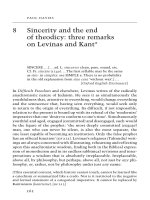
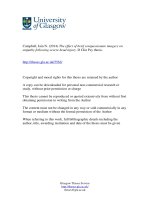

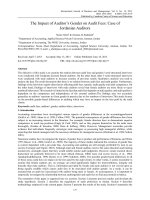
![daniels and booker - 2011 - the effects of audit firm rotation on perceived auditor independence and audit quality [mafr]](https://media.store123doc.com/images/document/2015_01/06/medium_sds1420548148.jpg)
![ionescu - 2014 - the effect of mandatory partner rotation on audit quality [mapr]](https://media.store123doc.com/images/document/2015_01/06/medium_fam1420548198.jpg)
